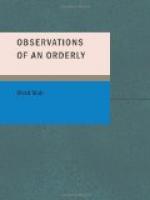“Which way now?” I inquired. My charge responded not, but crossed to a corner and meandered up one of those interminable thoroughfares which lead out of London into the suburbs. Trudging with him and helping him to sustain his balance, which was not as stable as could be wished, I plied him with mildly genial conversation and at last elicited a few vague answers. These were couched in the cockney idiom, but I caught a faint nasal twang which led me to suspect that the speaker had come from the other side of the Atlantic. Yes—he told me he had just arrived from Canada.
We had proceeded a short distance when on the further side of the street I descried a golden halo which outlined the silhouette of a coffee stall. It occurred to me that a cup of hot coffee would be a good tonic to disperse the last symptoms of my friend’s indiscretion, so I deflected him across the road, and we brought up, together, alongside the coffee-stall’s counter.
Lest the reader should be unacquainted with that unique creation, the coffee-stall, I must explain that it is nocturnal in habit, emerging from its lair only between the hours of 11 p.m. and 7 a.m. It is an equipage of which the interior is inhabited by a fat, jolly man (at least according to my experience he is always fat and jolly) surrounded by steaming urns, plates of cake, buns of a citron-yellow hue, pale pastries, ham sandwiches and packets of cigarettes. The upper panels of one of its sides unfold to form a bar below and a penthouse roof above, the latter being generally extended into an awning. The awning is a protection for the customer not against the sun—a luminary from whose assaults the London coffee-stalls have little to fear—but against the rain. Thanks to these awnings, and the chattiness of the fat, jolly man, and the warmth exhaled by the urns, and the circumstance that the public houses are shut, our coffee-stalls are able to sell two brownish beverages, called respectively coffee and tea, which otherwise could hardly hope to achieve the honour of human consumption.
Fate has guided me on many midnight pilgrimages through the town, and I have imbibed, sometimes with relish, the liquids alluded to; I have also partaken of the pallid pastry and the citron-yellow buns. I am therefore in a position to write, for the benefit of persons less well informed, a treatise on coffee-stalls. This I shall refrain from doing. The one point it is necessary for me to mention is that the fat, jolly man, being deplorably distrustful, does not supply casual customers with teaspoons. You may have a cup of alleged tea (one penny) or a cup of alleged coffee (one penny); a dollop of sugar is dropped into the cup; the fat, jolly man gives the mixture a stir-round with a teaspoon; then he places the cup before you on the bar; but the teaspoon is still in his grasp. I dare say he would lend you the teaspoon if you requested him to do so; but unless you have that audacity he prefers to keep the teaspoon on his side of the bar, out of harm’s way. This may seem strange, when you perceive that the teaspoon is fashioned of a metal unknown to silversmiths and might be priced at threepence. But even a threepenny teaspoon is a souvenir which some collectors would not despise.




